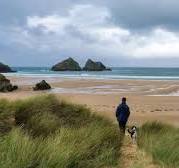Leaving home in the dark is fine at certain times of the year when it doesn’t require getting out of bed at some ungodly hour and still being able to watch the sun coming up. I was at Holywell Bay recently just before the sun came over the top of the hill and before all the dog walkers came to fill the beach and the dog poo bins!
The freshness of the day and the colours of the sky were beautiful as were the plumes of white where the waves crashed into the base of the cliffs, another named storm had passed through the previous day creating a very rough sea.
We walked along the coast path skirting Penhale camp, with all the old barracks looking shabby and neglected, broken windows as well as weeds and brambles adding to the desolate appearance. Chain link fencing and razor wire surrounds the actual camp and there has been a battle between the authorities and property developers to get planning to build holiday homes which, in my opinion, would ruin the whole area.
Round the headland at Ligger Point we were walking straight into the wind, causing Eddie to wear his ears flat against his head and me to lean forward to keep the momentum going. Once round the point it became a little easier as we headed for Perranporth, the long beach stretching away with only one couple and a dog enjoying the bracing air. There was never any danger of falling off the cliff even though the path passes close to the edge because the wind would keep even the most unsure walker well on the track. Eventually we came down onto the beach, where I could let Eddie off the lead and he could put his foot down and accelerate along the sand doing his canine version of loop the loop. There were countless cuttlefish scattered along the sand, not to mention bits of plastic and net washed in on the last tide.
I walked along the beach and then climbed up a track through the dunes to pick up another path that comes behind the whole length of the beach but following the red and white markers that are the boundary of the military zone. Passing through a broken handgate turn left and follow the well-worn path inland, where the view of the expansive sand dunes took me by surprise, I hadn’t realised they were so vast and cover well over 2,600 acres. There were a lot of hawthorn trees laden with masses of red berries which provide winter-long feeding for birds and I was delighted to hear a skylark singing even though it was November. In the springtime the whole dunes area is renowned for the cowslips that grow in abundance here.
Slightly to the right of the path stands a large concrete cross to indicate the proximity of St Piran’s oratory and once you climb up the mound to the cross it is easy to see. The ancient chapel is now in ruins and has at various times been covered in sand although in 1910 an ugly concrete ‘shed’ was built around it to prevent it being swallowed by blowing sands again but by 1980 it was lost once more only to be excavated yet again in 2014. Walking a little further a tall granite cross is seen and close by are the remains of the ruined St Piran’s church. Each spring on St Piran’s day, 5th March, hundreds of people along with druids make a pilgrimage across the dunes to take part in a service at the ancient holy site.
Walking away and bearing slightly right the footpath is marked with occasional painted white stones which will bring you out to the council road,. We turned left and walked through the hamlet of Mount, with the spire of Cubert church on the skyline across the valley, before dropping downhill to the main entrance into Penhale Camp. The gates are locked but there is a footpath sign just to the right which goes through a field gate and out across the edge of the commons, keeping fairly close to a deep and fast-flowing stream. It is an easy path to follow but I wouldn’t say it was well used other than in the summer, when there are more people around and not so much standing water everywhere. A wooden marker post takes you into the willow trees and comes to a strong wooden bridge across the river and into a well enclosed and ancient lane which emerges at Trebisken. Bear left into another lane which will now take the walker across two fields before passing behind Ellenglaze. Coming out onto a dead-end road, turn left for a short way and at a turning place pick up the footpath on the right which follows the river, passing through a holiday park and this will bring you out into the village of Holywell where this walk started.
Erica Simpson


